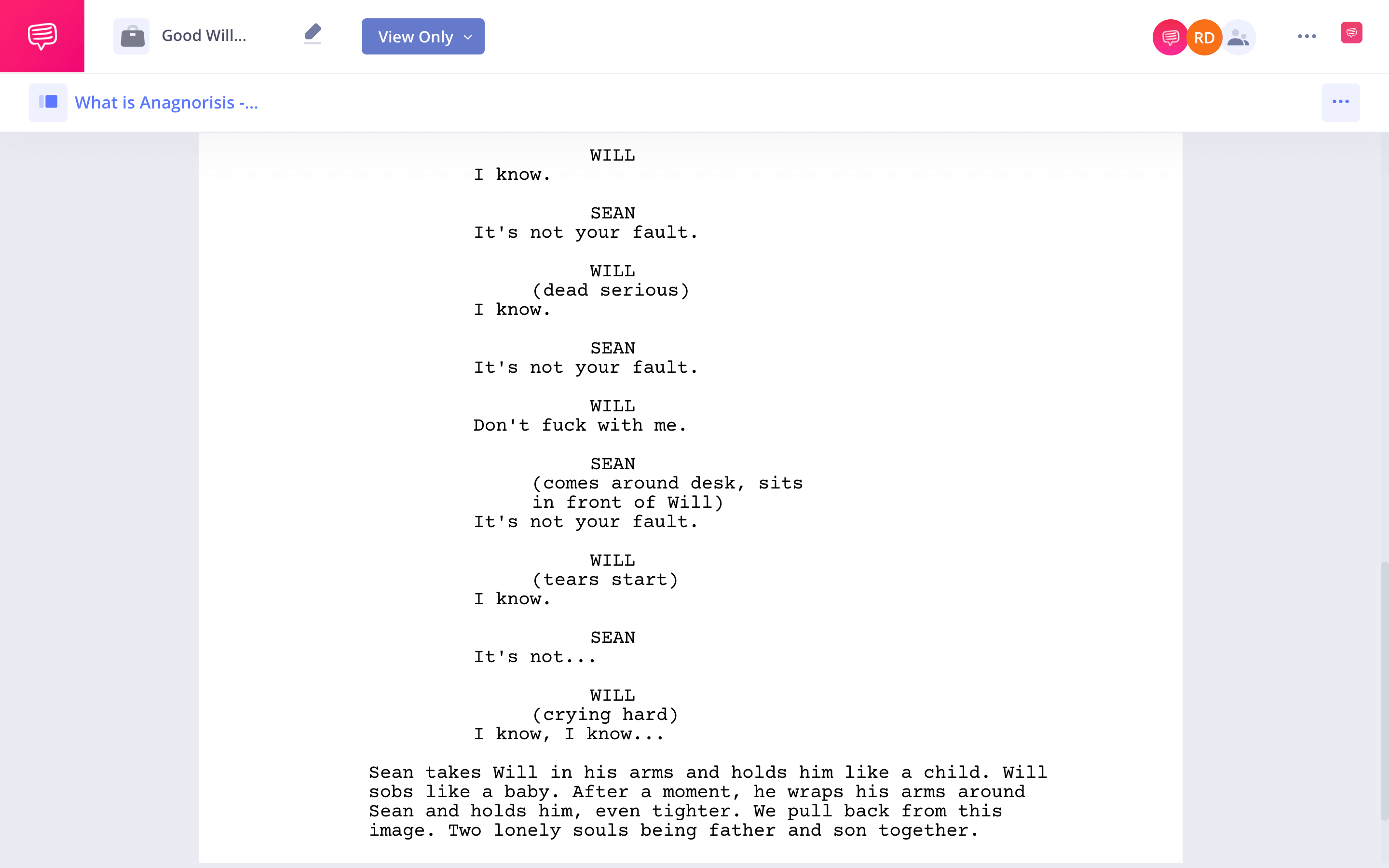Anagnorisis is a literary device that has been used for centuries to create dramatic turning points in stories. In this article, we will explore the origins of anagnorisis, how it works as a storytelling technique, and some examples of its use in popular works of fiction.
Whether you are an aspiring writer or just curious about the art of storytelling, understanding the anagnorisis definition and function can help you appreciate how great stories are crafted and leave a lasting impact on your readers or viewers. Because of the function of anagnorisis, there are major spoilers ahead in this article.
What is Anagnorisis in Film and Literature?
First, let’s define anagnorisis
Before diving into some examples of anagnorisis let’s first look at the anagnorisis definition to fully understand the literary term.
ANAGNORISIS DEFINITION
What is Anagnorisis in Story?
Anagnorisis is a literary term that refers to the moment in a story when a character makes a critical discovery or realization, often leading to a dramatic turning point in the plot. It is derived from the Greek word "anagnōrisis," which means "recognition" or "discovery." Anagnorisis can occur when a character suddenly understands their true identity, discovers an important truth about another character, or realizes the significance of past events.
This revelation usually leads to heightened tension and conflict, propelling the story toward its climax. Anagnorisis is commonly found in Greek tragedies and Shakespearean plays, but it can also be used in other forms of literature such as novels, short stories, and films.
Examples of anagnorisis in literature and film:
- Romeo and Juliet by William Shakespeare — Romeo discovers that Juliet is not actually dead, leading to tragic consequences for both characters.
- The Matrix directed by The Wachowskis — Neo realizes that he is the prophesied savior of humanity and gains new powers as a result.
- Harry Potter and the Deathly Hollows by J.K. Rowling — Harry discovers that Snape motivations have not been malicious but protective.
Anagnorisis Meaning
Anagnorisis examples
Anagnorisis is an extremely effective storytelling technique, so it should be no surprise that it can be found in countless pieces of literature. Let’s look at a few of them including an iconic example of anagnorisis in Oedipus Rex.
Oedipus Rex
This play by Sophocles has perhaps the most famous anagnorisis of all time. The grand realization? Oedipus finds out that he has in fact killed his dad and, to make matters worse, married his mom. Yikes.
It’s a pretty huge anagnorisis completed with a pretty huge reaction: Oedipus blinds himself.
Star Wars: Episode V
Another very famous anagnorisis can be found in Star Wars. Can you guess it? Hint: it begins with “No” and ends with “I am your father.”
Fight Club
This is a particularly unexpected anagnorisis, so be warned: spoilers ahead. The Narrator realizes in the third act that he is in fact Tyler – Tyler’s separate identity is actually a delusion.
Now he has to figure out how to stop him. Don’t worry, we won’t spoil how he does that.
Macbeth
Leave it to the Bard to chef up a particularly delicious anagnorisis. Macbeth believes he’s essentially invisible: he’s been told that he can be killed by no one born of a woman. So, no worries, right?
Well, Macbeth realizes there’s an unfortunate loophole: Macduff was removed from his mother via C-section. Macduff can kill him.
Anagnorisis Definition
Anagnorisis and Peripeteia
Are your eyes glazing over at the title of this section? Is it “all Greek to you”? Have no fear. Let’s differentiate anagnorisis and peripeteia, two terms which are often confused.
Peripeteia refers to a sudden reversal of fortunes for a character. In a matter of seconds, a character is plopped into a new context.
An example: a professional poker player enjoys the ranks as one of the most talented card players in the world, making millions. But when he’s outed for cheating, he is ruined by fines and on the run from the law.
Another example can be found in It’s a Wonderful Life when Billy misplaces the money. Everything is turned upside-down for George after that moment.
Billy’s big mistake
As you can see, these examples have nothing to do with a character’s own realization, as is required in anagnorisis. Anagnorisis may result in peripeteia, like it does for Oedipus, but the two terms are distinct.
Anagnorisis Meaning in Story
What is anagnorisis used for?
Anagnorisis is a powerful tool for writers and filmmakers, allowing them to create dramatic moments of realization that deepen audience engagement with characters and storylines. When a character experiences anagnorisis, they are coming to a sudden realization or understanding about something that was previously unknown or misunderstood. This moment of realization can be incredibly impactful for both the character and the audience.
For the audience, anagnorisis can create a sense of empathy and connection with the character. As readers or viewers, we often find ourselves rooting for characters and hoping for their success. When a character experiences anagnorisis, it allows us to understand them on a deeper level, which can make us feel more invested in their journey.
Adds depth to characters
By revealing hidden motivations or backstory, anagnorisis can help the audience better understand why characters act the way they do and what drives them. A great and heart-wrenching example of this can be found in Kenneth Lonergan’s Manchester by the Sea script.
At the moment Lee Chandler realizes his brother has left his son to the supervision of Lee, we also flashback with Lee to the trauma he experienced of the loss of his own children in a fire.
Manchester by the Sea Movie CLIP • I Don't Understand
The anagnorisis of Lee learning he is now responsible for his nephew Patrick also reveals key details from his past.
Creates plot twist
Furthermore, anagnorisis can also deepen our understanding of the story itself. Often, these revelations are linked to major plot points or plot twists that change how we perceive the narrative as a whole. This can lead to a greater appreciation of the story's themes and motifs as well as its overall structure.
In arguably one of the most iconic moments of anagnorisis in cinematic history, the plot twist of The Sixth Sense does exactly this.
MAJOR SPOILER ALERT!
The Sixth Sense (1999) • Ending Scene
Throughout the movie, we are led to believe that Dr. Malcolm Crowe (Bruce Willis) is helping a young boy named Cole Sear (Haley Joel Osment) who sees dead people. However, at the end of the movie, we learn that Dr. Crowe himself is actually dead and has been helping Cole from beyond the grave.
This revelation completely alters our understanding of everything that has come before in the story and forces us to reevaluate our perception of both characters.
Provides catharsis
Finally, anagnorisis can provide a sense of catharsis for both characters and readers. By coming to a sudden realization about themselves or the world around them, characters can experience emotional growth that is satisfying for both them and the audience.
One of the best examples of this can be found in Good Will Hunting. In this moment between Will and Sean, all of the walls Will has built up finally come down and Sean finally breaks through. Will realizes he is not at fault for his trauma and he is not responsible for bearing the weight of it all on his own.
Here's the scene we brought into StudioBinder’s screenwriting software:Will's Realization • Read the full scene
Writers Ben Affleck and Matt Damon heighten the anagnorisis through repetition. Will needs to hear this again and again for it to truly get to him– this isn’t an easy revelation to come by.
The ending of the scene, therefore, is extremely powerful: Will sobbing, held by his only father figure.
Now, watch the final result:
Good Will Hunting • 'It's Not Your Fault'
Overall, anagnorisis is an effective tool for engaging audiences with characters and storylines because it helps us connect with characters on a deeper level while also providing new insights into the narrative itself. Let’s take a look at a few ways to incorporate it into your writing.
Related Posts
What is Anagnorisis in Writing?
How to Incorporate Anagnorisis
Anagnorisis is a powerful technique that has been used in literature, theater, and cinema for centuries. Let’s take a look at a few ways to incorporate it into your writing.
Plan ahead
Anagnorisis often involves a sudden realization or understanding that changes the course of the story. To effectively incorporate this element into your writing, it's important to plan ahead and know where you want to take the story. Consider what revelations or insights would be most impactful for your characters and how they can change the course of the narrative.

The Sixth Sense • What is Anagnorisis in Film?
Build tension
Anagnorisis is often most effective when it comes as a surprise to both the character and the audience. To create this sense of surprise, it's important to build tension leading up to the moment of realization. This can be done through foreshadowing or by creating conflicts that force characters to confront their beliefs or assumptions.

Get Out • Building suspense
Use symbolism
Symbolism can be a powerful way to hint at hidden meanings or themes that will eventually be revealed through anagnorisis. By incorporating symbolic objects, actions, or dialogue into your writing, you can create a sense of mystery and intrigue that will keep readers engaged until the moment of revelation.

The Matrix • Blue pill, red pill
Show, don't tell
When it comes time for anagnorisis, it's important to show rather than tell. Instead of simply having a character explain their sudden understanding, try to convey it through their actions and reactions. This will make the moment feel more organic and believable while also allowing readers to experience it alongside the character.
Use anagnorisis sparingly
While anagnorisis can be a powerful tool in storytelling, it's important not to rely on it too heavily. Overusing this technique can make your writing feel predictable or contrived, so consider using it only once or twice throughout your project.
By revealing a character's true identity or hidden motives, anagnorisis can create a sense of surprise, shock, or catharsis in audiences. It allows us to see the world and ourselves in a new light, and it challenges our assumptions about what we think we know.
Whether it's through symbols, foreshadowing, or building tension, anagnorisis remains a timeless tool for storytellers to explore the human experience and reveal deeper truths about the world around us. From Shakespeare's tragic heroes to modern-day thrillers like The Usual Suspects, anagnorisis will continue to captivate and engage audiences for generations to come.
Up Next
What is a Plot Twist?
Anagnorisis is a great literary tool to create a plot twist within a story. If you’re looking to create a plot twist in your writing, check out our next article where we take a closer look at the story device.


